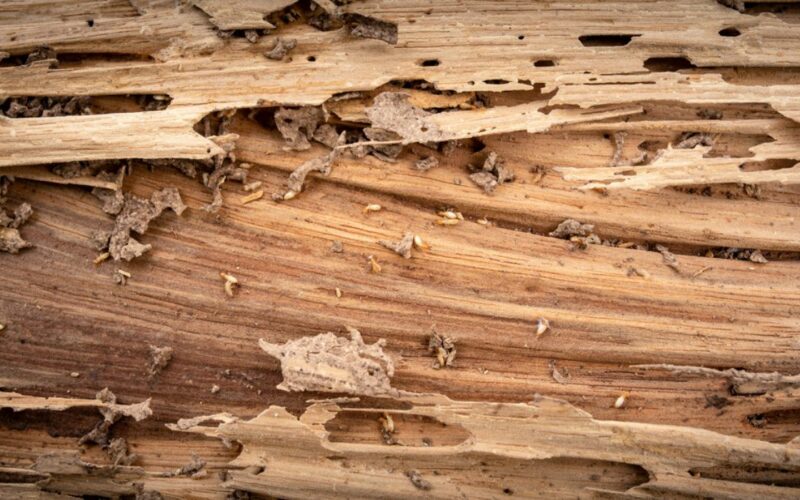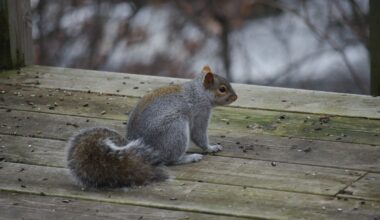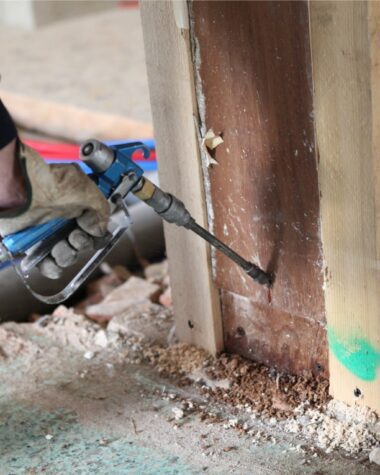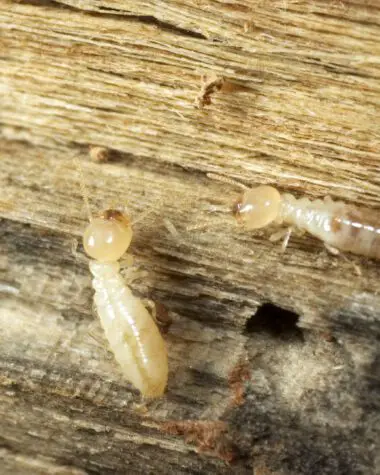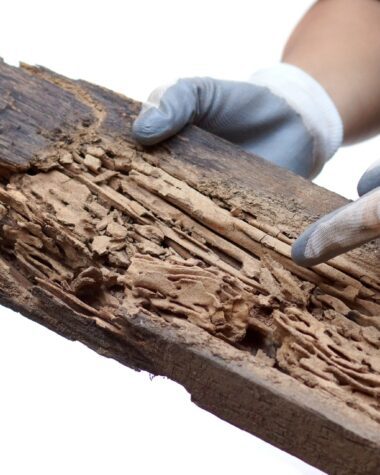More wood is getting replaced yearly due to serious infestation damage. Wood infestations can severely threaten a building’s structure or even cause elegant furniture to decompose into dust particles.
Biological pests usually target healthy, living trees, but many more attack lumber, dry and seasoned wood, and other structures weakened by different conditions, such as exposure to environmental elements, old age, and poor maintenance.
These pests may be a serious threat as they can reinfest wood until it leads to irreparable damage or expensive treatment. In fact, repairing and controlling wood infestation problems can cost you thousands.
Biological pests can primarily be grouped into wood-decaying insects and fungi or mold. But, killing these pests may not completely end wood infestation because several factors may still contribute to wood-decaying problems.
Here’s a complete guide about a wood infestation, its causative factors, and easy-to-follow tips on preventing and treating it.
Lesser Known Wood Infestation Facts
Before we proceed to the in-depth understanding of wood infestation, here are a few facts to lighten up the topic.
Did you know some woods are natural insect repellants?
Redwood and Cedar are special wood types with natural oils that protect them from insects. Other bug-resistant woods include super hardwoods like Ipe, which are so dense and hard to chew on for some pests.
In fact, Cedarwood oil is even used as an active ingredient for commercial insecticides However, long-term exposure to relatively high levels of cedarwood oil can cause liver and pulmonary toxicity in humans and pets. The US Environmental Protection Agency warned manufacturers that organic-based insect repellents should have low levels of Cedarwood oil to avoid extreme toxicity.
Going back to the wood type, studies also found that repeated occupational exposure to cedarwood might promote chronic lung damage and asthma. Hence, you should wear proper protective gear when working for long hours with this wood type.
Another fun fact is that trees secretly communicate to send warning signals against pests. Evidence suggests that certain wood types, like maple, under a certain pest attack, send an airborne signal to warn about impending danger. The undamaged trees would then begin secreting bug-repelling chemicals to drive off insects.
So, how serious are wood infestation problems worldwide, and what is the worst possible cause? Termites are considered the most destructive wood-infesting insects. In Australia alone, 80% of all households are near a termite nest and vulnerable to a possible infestation. That leads to an Australian CSIRO report which stated that 1 in 5 homes experienced termite attacks within the first five years of construction!
In the US, 600,000 houses are infested by termites each year. And the estimated cost of all the wood-infested damage and repair is a whopping $5 billion annually. Based on reports, you can clearly see that wood-decaying pests are a huge problem worldwide.
Related Post: Facts and Myths about Termites
Insect-Resistant Wood Types
If you worry about a possible wood infestation, the best thing you can do to control bug issues is to choose the right materials that do not attract pests. Here are the most recommended wood types that are less attractive to wood-decaying insects.
Cedar Wood
Cedar is a widely used wood type suitable for many woodworking projects, such as furniture making, fencing, and other applications. This wood type is popular because it is naturally immune to bug attacks. Cedar Wood repels insects by releasing natural chemicals and oils.
Also, this wood’s strong aroma is less attractive to pests, so using a Cedar for your wood projects will minimize pest invasions and help protect your woodwork from possible wood-infested damages.
Redwood
Redwood is a popular choice for outdoor woodworking applications. Its color and grain are attractive even in an unfinished state, but more importantly, it is resistant to wood-decaying pests. Redwood’s resistance to insects and fungi is due to its chemical agents known as tannin.
The high percentage of tannin in Redwoods not only gives a stylish reddish color but also acts as an outer layer covering that gives the wood a natural treatment that protects it from bug attacks and decay.
Mahogany
Mahogany is one of the most outstanding wood types, known for its rich color, attractive grain, and excellent workability. But its best characteristic is its natural stability and durability. Not only is it stable against moisture and atmospheric changes, but Mahogany also has unusual resistance to decaying elements such as pests, mold, and others.
Mahogany is highly resistant to the attack of wood termites, making it commonly recommended for construction woodwork over the years.
Black Locust
Black Locust is considered one of the strongest and most insect-resistant woods globally. It is an incredibly resilient and durable wood material that can withstand years of outdoor exposure. The wood is naturally resistant to wood-decaying elements such as insects and other pests. It has natural characteristics that make this wood impervious to the worst pests, such as Carpenter Bees.
Yew Wood
Yew Wood is a very durable and decay-resistant softwood. It is a softwood, but it is harder than many hardwoods due to its high density. It is commonly used in making cabinetry, furniture, and musical instruments. Yew Wood works well in both indoor and outdoor woodwork applications. It has excellent resistance to wood-decaying insects, fungi, and bug attacks.
Cypress Wood
Cypress is an extremely insect-resistant wood due to its naturally produced preservative known as cypressine. This characteristic makes it ideal for construction, decking, flooring, and other woodwork applications. Cypress naturally creates an oily resin that makes the wood decay-resistant and, at the same time, repels most insects and other pests.
Related Post: Types of Woods That Attract Termites
Identifying Wood Infestation
You may not realize that you have a possible wood infestation problem until the damage becomes huge, so early identification is one way to reduce or possibly stop further harm. Here are useful tips when identifying wood infestation at home.
Wood Infestation Inspection
Wood infestation usually shows early warning signs that you can visibly notice among your woodwork. First, you may see weak and damaged floorboards or furniture with corners or edges that slowly crumble. This indicates a possible wood infestation. You can also see hollow holes or tunnels in the wood, usually oval-shaped with sharp edges, indicating that pests may have passed or invaded through your wood.
In some worse cases, you can see dust droppings near your furniture. This is possibly caused by pests that consume the wood and often leave behind brown-colored and grainy fecal mounds. These fecal pellets are usually found beneath the infested wood.
Suppose you want to do the wood infestation inspection job professionally. In that case, you can also call experts that offer services like these. Just ensure you follow the guides and prepare your area prior to the inspection.
Related Post: Termite Inspection and Treatment Cost Guide – Is It Worth It?
Signs of Wood-Destroying Insects
Different types of insects can attack your wood. Luckily you can easily identify each type and determine the best solution to get rid of them. Around the area of a possibly infested wood, you can spot evidence of insects living on your property.
First, if you can see mud tubes on your wood, this indicates that your furniture may be infested with termites. These mud tubes are shelters for termites made of mud, dirt, and debris, where they can also travel without being seen. These tubes are usually found on the exterior and interior of the wood.
You can also identify wood-borer insects through the eggs and larvae that you may find near an infested wood and are usually located in cracks of wooden objects, floorboards, and timbers. You may also notice bore frass or whitish-yellow powdery dust caused by adult beetles.
Related Post: How To Identify Wood Ticks and Handle Them
Another way to identify a wood infestation is by analyzing the wood-infested damage, like termite damage. The most visible signs of a termite attack include buckling wood, swollen floors and ceilings, areas that may look like water damage, and mazes within walls or furniture. A scent similar to mildew or mold can also identify termite infestations.
Aside from termite damage, other visible signs are woodworm infestations. Tiny holes of around 1 and 3 mm in diameter are the most obvious sign of a woodworm attack. In these holes, woodworm plants their larvae until they hatch into adult beetles which bore their way to the surface of the wood.
Fine, powdery bore dust is also a sign of woodworm, often found near woodworm exit holes. You can also notice tunnels in the wood that cause weak and damaged floorboards. Another indicator of a woodworm attack is the emergence of dead beetles outside an infested wood.
Related Post: Woodworm Infestation and Treatment Products: Everything You Need to Know
Wood-Destroying Insects vs. Fungi
As mentioned above, biological wood pests can be grouped into wood-destroying insects and fungi. The most common wood-destroying insects are woodworm, longhorn beetles, powderpost beetles, sawflies, and termites. They attack in both freshly cut and dry woods.
Insects usually hatch their eggs and larvae to continuously reinfest a wood. They even create tunnels, exit holes, and shelters in the exterior and interior of the woods, causing the greatest damage. After eating away at the infested woods, these insects often leave wood frass or dust particles.
Related Posts:
- Help Is Here: Why Termites Eat Wood And How To Stop It
- Do Ants Eat Wood?
- Can Wood Roaches Infest Your House?
When it comes to wood-decaying fungi, the most vulnerable woods are those exposed to moisture, conducive temperatures, a suitable air volume within the wood, and even an acidic environment. And the worst part about fungi infestation is they can move across your furniture without you noticing.
Fungi penetrate and spread across woods to expand infestation. They rapidly spread and reproduce under optimal temperatures in the form of spores that travel through the air within the wood. The only sign you may notice is a rusty plague in brownish color which may indicate fungi spore formations.
Fungi are extreme threats since they can attack wood in storage and processed and built-in wood by decomposing its cells. Also, fungi leave wood stains after infestation. Although wood-staining fungi do not weaken the wood, they can attract wood-decaying insects and reduce the wood’s resistance to pest infestation.
Factors That Cause Wood Infestation
It seems nearly impossible to avoid biological wood pests as they can be as little to unnoticeable when starting an infestation. However, you need to keep in mind that other factors make your property prone to pest infestation.
Remember, pests invade an area when there is access. You must identify and fix possible entry points that allow pests to enter. Also, you need to identify the possible factors that attract these pests, such as food, water, moisture, and even humidity.
For example, leaky pipes, broken drainage, and poor airflow can create moisture that attracts pests that particularly thrive in humid environments. Thus, the simple solution is to make your area unavailable to pests where they are unable to live and spread.
Related Post: How to Tell the Difference Between Rotten Wood and Termite Damage
Wood Infestation Preventive Measures and Treatment
Suppose you identify the possible causes of wood infestations and the pests invading your property. Here’s a list of what to do and solutions you can apply to eliminate wood-destroying pests.
How to Prevent Wood Infestation
Prevention is always better than cure. Instead of waiting for early signs of wood infestation, you can start taking preventive measures such as using pesticide spray. Some non-toxic chemicals and repellents are safe for humans and pets and, at the same time, effective in keeping pests away.
But if you do not want to risk using commercial pesticides, you can use natural insect-resistant wood materials like the wood types listed above. These wood types have natural oils that repel pests, making them more effective and safer in indoor and outdoor woodwork applications.
Another way to prevent wood infestation is to always watch out for your woodwork and the area where you place them. Always ensure that pests have no access to your property by considering factors that attract them. Seal up any holes or possible entry points. Send water away from your woodwork because constant exposure to water can lead to rotting, which is highly attractive to pests.
Also, as much as possible, avoid moisture issues since it extremely lures pests into your area. Make sure your attic, basement, or other empty rooms and spaces are dry and well-ventilated. Ensure equipment such as air conditioners are inspected for condensation lines or other issues that may cause unusual moisture indoors.
Related Post: Protect Your Home: Plants That Scare Away Termites
Commercial and Natural Remedies to Eliminate Wood-Destroying Pests
Once you notice an occurring wood infestation, you need to take the necessary steps to control the damage. You can consider using commercial pesticides, such as placing liquid barriers around the infested areas to poison pests upon coming into contact with it.
Direct chemicals sprays are also available to use in interior applications. This is the best option for wall cracks, crevices, and confined spaces. The trick is the chemical foam expands to kill pests hiding in narrow corners and hard-to-find places. It even leaves a residue that lasts for months and prevents further infestations.
Related Post: Top 5 Anti-Termite Chemical Treatment for Wood
If you are not a fan of using extremely toxic pesticides, you can choose natural remedies against wood pests. Boric Acid is mostly recommended as a natural pesticide to eliminate wood-destroying pests. It usually comes in powder form and can be simply mixed with water. You can use the solution to spray on the infested area, but it is still advisable to wear gloves and masks while spraying.
Another natural remedy for wood infestations is apple cider vinegar, which contains acetic acid. The acid is effective in killing and destroying the pests’ exoskeletons. There are also essential oils that work well against pests and are safer for humans and pets. You may also consider natural factors such as leaving your infested furniture under the sun to kill the critters.
Wood Infestation Treatment and Restoration
Once the damage has begun, the most effective way to control and stop the spread of wood infestation is to separate and isolate a badly infested wood with a huge population of pests. This will prevent affecting other good wood with infestation.
Next is to eliminate the eggs and larvae by spraying pesticides that can kill them. Doing so ensures that no other adult pests can emerge and reproduce on the wood. After eliminating the pests, you must improve sanitation and organize or discard any clutters.
If the infestation damage is not severe and you completely eliminate the pests, you can still restore and reuse the wood. All you have to do is to ensure that your area is thoroughly sanitized, reconstructed, and restored into a new healthy environment for your woodwork.
You have several options when restoring damaged wood. You can remove and replace certain severely damaged parts or add support for the damaged wood. In most cases, adding support is considered less expensive and easier to do than replacing structural parts. But, if you want to do the restoration professionally, some companies offer advanced services.
Discover More About Wood Infestation Solution
- Infested Wood Restoration
- Wood Disinfection Treatment
- How To Get Rid of Wood Borers
- How To Get Rid of Wood Mites
- Dog Eating Wood: What To Do About It
- How to Stop Squirrels From Chewing Wood (Step-by-Step Guide)
- Wood Infestation: Frequently Asked Questions
Conclusion
Wood infestation is a real problem when doing woodwork in either indoor or outdoor applications. Biological pests like insects or fungi usually cause these issues that lead to irreparable damage. Luckily, there are commercial and even natural remedies to eliminate wood-destroying pests. You can start with inspecting wood infestation and understanding its causes and possible treatment to successfully find effective solutions.
